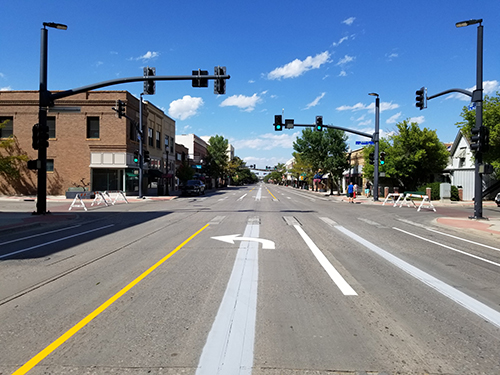- Home
- Administration
- Aeronautics
- Business with WYDOT
- Construction Projects
- Driver License and Records
- Economic Stimulus Projects (ARRA - TIGER)
- Engineering and Technical Programs
- Fuel Tax
- Highway Safety
- Human Resources
- Manuals and Publications
- News and Information
- Permits
- Planning/Projects/Research
- Titles, Plates and Registration
- Travel
- Trucking / Commercial Vehicles
- Vehicle Business Regulation
- Wyoming Highway Patrol
- Search
- Sitemap
Sheridan Main Street test shows positive results
September 20, 2019
 SHERIDAN – The Wyoming Department of Transportation and the city of Sheridan hosted a public meeting on Sept. 17 to share and discuss the results of the three-lane reconfiguration test of Downtown Main Street.
SHERIDAN – The Wyoming Department of Transportation and the city of Sheridan hosted a public meeting on Sept. 17 to share and discuss the results of the three-lane reconfiguration test of Downtown Main Street.
On Aug. 11, at the request of the city of Sheridan, a half-mile portion of the historic downtown Sheridan Main Street went from its traditional four-lane configuration to three-lanes. This reconfiguration was a result of months of conversations between WYDOT and the city to take advantage of the upcoming resurfacing of this portion of Main Street in 2023 to look at how it might function under a new traffic design.
This type of study is the first of its kind for WYDOT and provided an opportunity to conduct a real-time study which included the community, and gathered both qualitative and quantitative data. This study was completed without using obtrusive cones, flagging operations or other vertical traffic controls, and it worked rather seamlessly.
Traffic study results
Final traffic studies performed by WYDOT indicate the three-lane configuration appeared to function adequately at peak periods. Adjusted traffic signal timings ensured good progression and for the most part queues were not excessive. The study also indicated there was no significant change in traffic volumes on Main Street or the bordering streets of Gould and Sheridan.
WYDOT’s count locations included the signalized intersections on Main Street between Burkitt and Dow, as well as the intersections of Coffeen and Gould and Sheridan Avenue and 5th Street. The counts off Main Street were intended to determine what alternate routes drivers were taking if they avoided Main.
Comparisons of before and after volumes on Main Street showed little change overall in the input and output. The midday hour from 11 a.m. to 12 p.m. was the only one that showed any trend for significant drop in volumes with a reduction on the order of approximately 10%. The largest reduction observed was 125 fewer vehicles on Main Street during the midday hour in the first week of the test. During the third week of the test, this same hour measured approximately 70 fewer than the baseline. The PM peak hour, the busiest of the day, saw only minor changes with slight decreases and even some increases in Main Street volumes.
Data at the off-Main intersections did not show trends that would clearly indicate higher usage of these alternate routes. The 8 a.m. hour during the first week of the test did show an increase of 65 total vehicles on Sheridan Avenue - a 20% increase - but this was not replicated any other hour of the day. Noon and PM peak volumes on Sheridan Avenue remained essentially the same. The intersection of Coffeen and Gould showed no discernible increase in westbound right turners that would indicate people were using Gould to avoid Main.
Although the majority of the results provided positive feedback and data, areas of concerns were identified as well.
The four-foot “buffer zone” was often confused as a bike lane, which was not the intention. WYDOT strongly believes allowing bicycles to use the buffer as a bike lane introduces unnecessary conflict between vehicles and bikes and puts vulnerable cyclists at risk, even at the 20 mph speed on Main. “Dooring” incidents are a common crash type when narrow, non-separated bike lanes are allowed next to parking and can also force cyclists to abruptly swerve into the traveled way putting them at even greater risk.
The north end transition zone at Dow Street also raised some concerns. The original configuration did not allow enough time and length of roadway to enter the study area without congestion or confusion. This was identified as a concern during the first week of the study and a right-turn only was put into place at the Dow intersection of Main Street.
Public survey results
Preliminary public survey results were favorable the first week and continued to trend upward during the study. Final survey results showed 65% of those who participated in the survey were in favor of keeping the three-lane configuration, with 27% wanting to keep the four-lane configuration and 7% who were indifferent to the change.
The majority of the comments indicated the public felt safer when parallel parking due to the 4-foot buffer zone which offered added space to maneuver parking and enter and exit their vehicles. The public also stated that traffic felt less congested and they were able to notice businesses along Main Street they did not realize were there.
Under the original four-lane configuration there are no left-turns allowed during peak driving hours. Under the three-lane configuration there is a designated center left-turn lane which allows traffic to turn at any time. This change received mixed reviews from the public. Some public comments indicated they would prefer left turn arrows at the intersections to aid in their turning maneuvers. However, this is likely a poor option as left turn phasing would degrade progression and result in inefficient traffic flow on Main Street.
Next steps
As agreed upon with the city, the three-lane configuration will end at 9 p.m. on Saturday, Sept. 28 at which time Main Street will be closed for the removal of the temporary striping and preparation of the surface for WYDOT to restripe the four-lane configuration Sunday morning. The No Left Turn signals will be turned back on during peak hours and traffic will flow as before.
If the three-lane configuration is desired by the city in the future, modifications will need to be made to the traffic signals to align the signal heads properly with the travel lanes. WYDOT and the city [m1] will need to evaluate the existing traffic signal mast arms and poles for compliance to determine if they will meet design specs required for relocating traffic signal heads and signage. This is expected to take five to six months to determine.
If the city decides to move forward with implementing the change, there are a number of associated costs the city will have to pay for. Preliminary estimated costs range from $50,000 to $205,000. The city will review data and cost estimates and make a final determination. WYDOT will need to know the final decision by March 1, 2020 to meet design deadlines for the 2023 project.
Background
WYDOT is scheduled to resurface the downtown section of Main Street in 2023. The city saw this scheduled resurfacing project as an opportunity to investigate the idea of enhancing placemaking opportunities to increase foot traffic to the retail businesses.
In 2018, the Downtown Sheridan Streetscape Action Plan was created as a result of a multi-day workshop held earlier that year. The results of this study, which included focus groups and feedback from downtown retailers, indicated that reducing the now current four-lane configuration to three-lanes would offer a more inviting and accessible downtown.
For information about this news release, contact WYDOT District 4 public information specialist Laura Dalles at (307) 752-3022.





